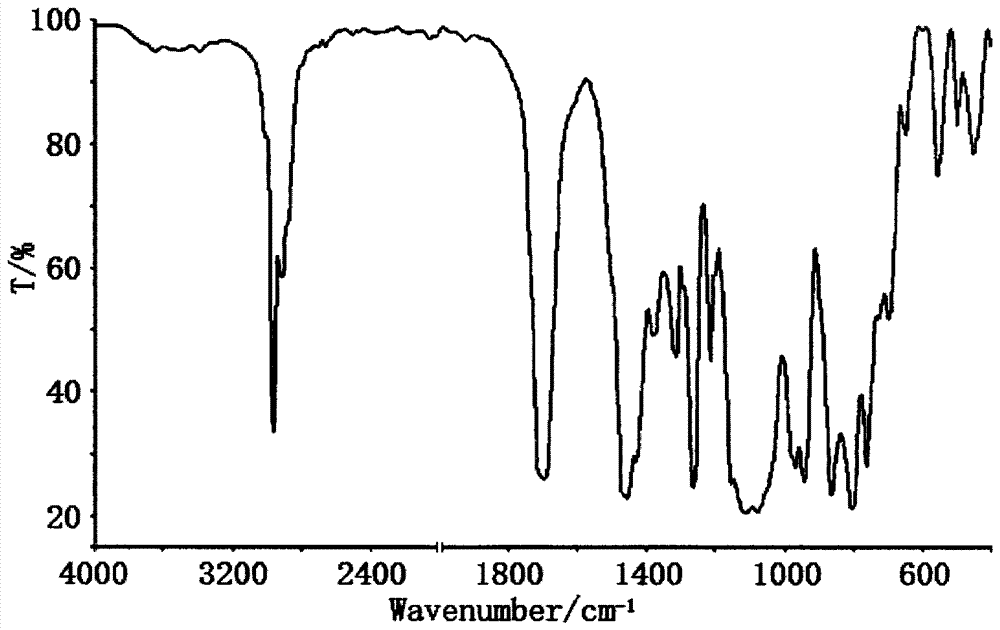Tris(dimethylhalopropoxysilyloxyhalopropyl) isocyanurate compound and preparation method thereof
A technology of dimethylhalopropoxysilyloxyhalopropyl and isocyanurate tris, which is applied in the field of isocyanurate triester compounds and its preparation, and can solve application restrictions and produce harmful and corrosive gases and other problems, to achieve the effects of large molecular weight, environmental protection, and high flame retardant efficiency
- Summary
- Abstract
- Description
- Claims
- Application Information
AI Technical Summary
Problems solved by technology
Method used
Image
Examples
Embodiment 1
[0034] Example 1 In a 250ml four-necked bottle equipped with a stirrer, a thermometer and a condenser tube, and a very expandable sealing sleeve at the top of the condenser tube, replace the air in the bottle with nitrogen, and add 9.91g (0.0333 mol) triglycidyl isocyanurate, 100ml dioxane and 12.91g (0.1mol) dimethyldichlorosilane, heat up to 100°C for 1h, keep warm for 5h; cool down to below 30°C, add 5.81g dropwise (0.1mol) propylene oxide, the reaction temperature is controlled by the drop rate to not be higher than 40°C, and the temperature is raised to 60°C 1h after the drop is completed, and the temperature is kept for 7h; (Dimethylchloropropoxysilyloxychloropropyl) ester, yield 94.9%.
Embodiment 2
[0035] Example 2 In a 250ml four-neck bottle equipped with a stirrer, a thermometer and a condenser tube, and a very expandable sealing sleeve at the top of the condenser tube, replace the air in the bottle with nitrogen, and add 9.91g (0.0333 mol) triglycidyl isocyanurate, 50ml diethylene glycol dimethyl ether and 12.91g (0.1mol) dimethyldichlorosilane, heat up to 95°C for 1h, keep warm for 6h; cool down to below 30°C, drop Add 6.20g (0.1067mol) propylene oxide, control the reaction temperature not higher than 40°C at the rate of addition, raise the temperature to 70°C 1 hour after the drop, keep the temperature for 5 hours; remove excess propylene oxide by atmospheric pressure distillation (recycling), Then, the solvent and a small amount of low boiling point substances were distilled off under reduced pressure to obtain tris(dimethylchloropropoxysilyloxychloropropyl)isocyanurate with a yield of 96.2%.
Embodiment 3
[0036] Example 3 In a 250ml four-neck bottle equipped with a stirrer, a thermometer and a condenser tube, and a very expandable sealing sleeve at the top of the condenser tube, replace the air in the bottle with nitrogen, and add 9.91g (0.0333 mol) triglycidyl isocyanurate, 70ml acetonitrile and 12.91g (0.1mol) dimethyldichlorosilane, heat up to 70°C, keep warm for 7h; cool down to below 30°C, add dropwise 6.78g (0.1167mol) Propylene oxide, control the reaction temperature not higher than 40°C with the rate of addition, and keep it warm for 10 hours at 40°C after dropping; remove excess propylene oxide (recycled) by normal pressure distillation, and then remove the solvent and a small amount by distillation under reduced pressure. The low boiling point was used to obtain tris(dimethylchloropropoxysilyloxychloropropyl) isocyanurate with a yield of 92.7%.
PUM
| Property | Measurement | Unit |
|---|---|---|
| decomposition temperature | aaaaa | aaaaa |
| density | aaaaa | aaaaa |
| decomposition temperature | aaaaa | aaaaa |
Abstract
Description
Claims
Application Information
 Login to View More
Login to View More - R&D
- Intellectual Property
- Life Sciences
- Materials
- Tech Scout
- Unparalleled Data Quality
- Higher Quality Content
- 60% Fewer Hallucinations
Browse by: Latest US Patents, China's latest patents, Technical Efficacy Thesaurus, Application Domain, Technology Topic, Popular Technical Reports.
© 2025 PatSnap. All rights reserved.Legal|Privacy policy|Modern Slavery Act Transparency Statement|Sitemap|About US| Contact US: help@patsnap.com



